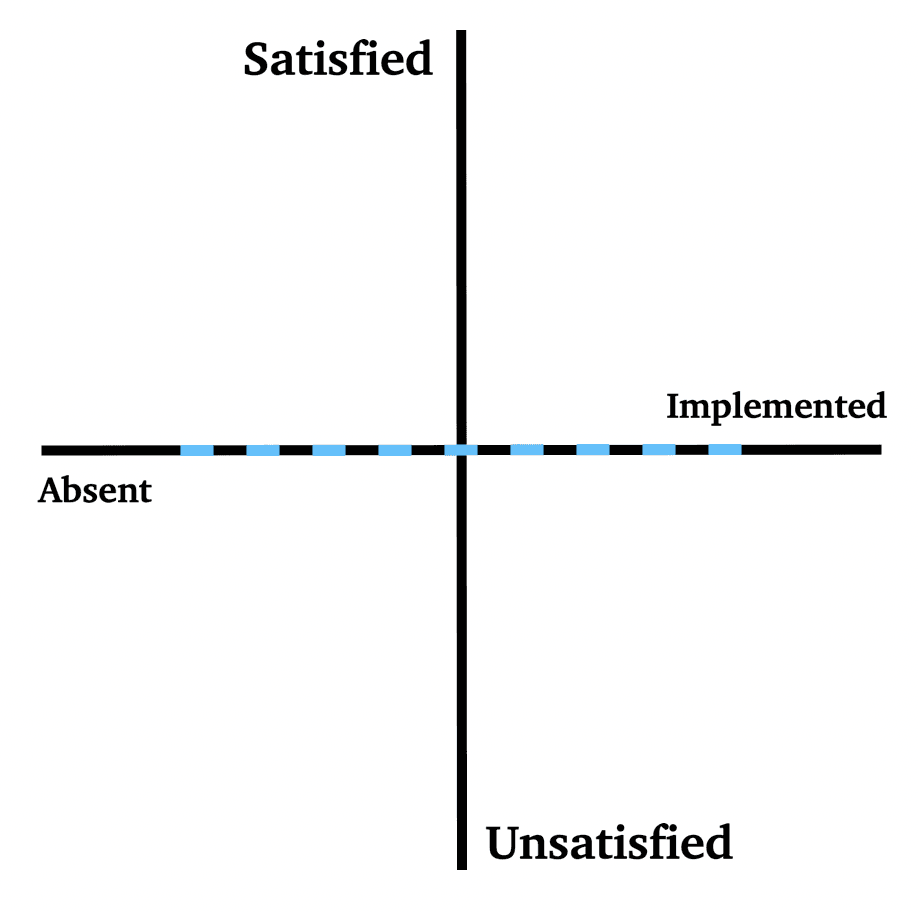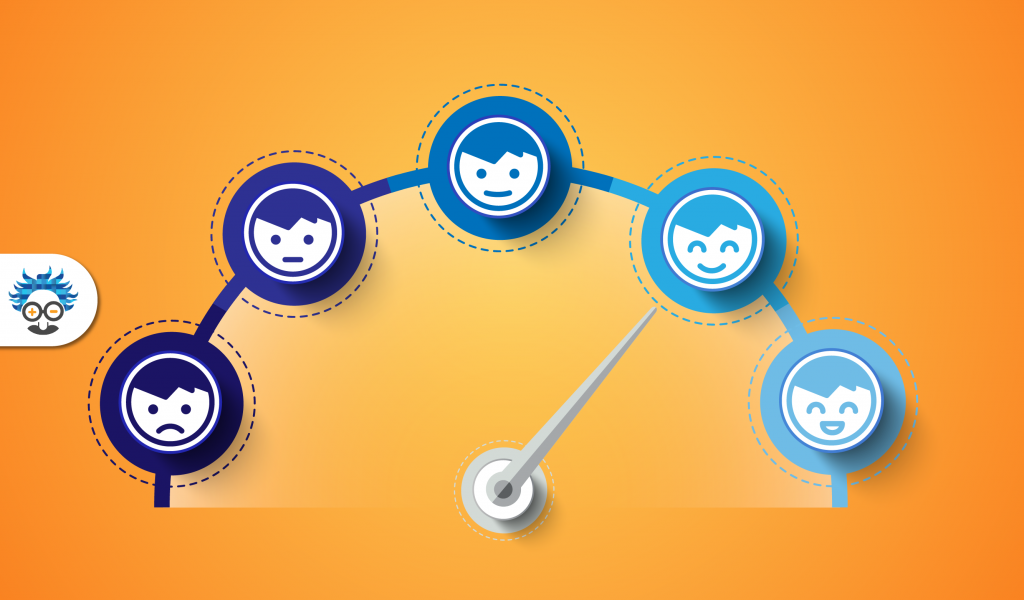What is the kano model? And how can a business follow it accurately?
Analysing what really matters to your customers isn’t as straight-forward as it should be…
…especially when you’re focussing on brand processes, user experiences and products/services.
The internet is packed with checklists, must-haves and guides for all of these points. However, I’m going to show you a different way of discovering just how satisfied your customers are, and more importantly, why they feel the way they do.
The model/theory that I’ll use to explain this was created for analysing product features (especially in product development) and their impact on customer satisfaction, but…
…by using them to analyse other parts of your business, you can benefit from a completely new take on your business’s strengths and weaknesses.
This is the Kano Model.
BTW: If you think this is going to be too high-brow or confusing, don’t worry! I will make this as simple and straight-forward as possible.
What is the Kano Model?
The Kano model was developed by Noriaki Kano, who published the theory in 1984.
The Japanese researcher’s purpose was to create a system that helped businesses analyse the relationship between specific product features and customer satisfaction.
BTW: A customer survey is a great way to garnish feedback, but sometimes customers can’t put their finger on why they like (or dislike) a brand, product or experience as much as they do. The Kano Model helps overcome that problem.

The Kano Model works by splitting features into 4 or 5 categories (depending who you speak to). For the purposes of this guide, we’re going to use 4 (because the 5th doesn’t have enough relevance for us!).
Each of these features has a different (and equally significant) impact on your customer’s opinion of your brand, and the Kano Model allows you to categorise them separately and understand each in their own way.
In simpler terms, it lets you separate and analyse features that are incomparable (even though you were probably comparing them previously).
How The Kano Model Works

The reason the Kano model isn’t as widely adopted as it probably should be is because on first viewing, it looks slightly complex.
When you view this chart as a whole, there are a lot of different things going on all at the same time, and that’s exactly why I don’t want you to look at it this way.
BTW: In order for you to really understand the Kano Model, stick with me (that means no skipping ahead or skim reading).
The Kano Model Chart (and Its Axis)
The Kano theory works by using a 4-quadrant line graph.
The two lines that cross-over and break the chart into 4 quadrants measure the success (and failure) of a brand, experience or product in terms of:
- Customer Satisfaction: This is the ‘y axis’ in the chart (aka the vertical line). The higher the line is marked on the chart, the more ‘Satisfied’ a customer feels in relation to a product feature, and the lower the line is marked, the more ‘Unsatisfied’ they feel.
- Performance/Implementation: This is the ‘x axis’ in the graph (aka the horizontal line). When a feature is better performing (because it’s been successfully implemented), it appears further to the right on the chart. When a feature performs worse (because it’s been poorly implemented) it appears further to the left of the chart.

As a business, you want every single analysed feature to appear above the horizontal line. This represents a feature that makes your customer feel satisfied and is well-implemented.
Anywhere below the horizontal line is where you don’t want to be. This represents a feature that makes your customer feel unsatisfied and has been poorly implemented.
In a perfect world, every feature of your business would positively affect customer satisfaction. However, there are some features that (by their very nature) cannot reach that level.
To help you understand, let’s take a closer look at the 4 Kano model features that you’ll need to analyse:
Kano Model Attributes/Features
This is where the really interesting stuff comes into play.
Now that you understand the foundations of the kano model graph, it’s time to look at those funky coloured lines.

These lines (aka attributes or features) were initially created to analyse elements of a product, but I’m giving you the freedom (and advice) to use them in any way you want, a few examples include:
- Brand performance
- Product features
- User experience
- Customer journey
- Community performance (in terms of subscribers and followers)
The key to using the Kano Model is to recognise each element of your desired object of analysis and place it in the correct attribute category.
For example, if I was analysing my customer journey, I would categorise the product receipt email into one of the following 4 attribute categories.
Don’t worry if that sounds a little confusing, it will become perfectly clear when you see each category.
Let’s get into them…
Performance Attributes
The performance attribute is represented by the red line that runs diagonally from bottom left to top right on the Kano Model Graph.

The performance attribute is the simplest attribute/feature to find and categorise. It denotes the ability of your product to carry out the task it is required to.
These are the core elements of the product/brand/experience. In other words, the features that allow your product to fulfil its role.
For example, on a computer this would be storage space or processing speed, on a mobile phone it would be battery life, on a car it would be acceleration, economy or reliability, in a buying process it would be ease of purchase (aka how many steps a customer had to go through), on a lawnmower it would be the blades that allow it to mow the lawn.
The Kano Model dictates that the more you put into your ‘Performance Attribute’, the more satisfaction the customer feels (and the red line on the graph shows this theory).
For example, if I was collecting leads for my business and I invested tons of time into eBook lead magnets, my leads would be much more satisfied with the experience, and I’d perform much better (and collect more leads). In contrast, if I spent 0 time creating lead magnets, I’d generate very few leads and those that I did collect would be less satisfied.
Excitement/Attractive Attributes
The excitement attributes are represented by the green line on the Kano Model graph.

As you can see, the excitement attributes can only have a positive effect on customer satisfaction and can make a massive difference to success, provided that they have been implemented and are performing.
Excitement attributes are like bonuses, in that they have 0 effect on the ability of your product to perform its function. They’re occasionally unexpected or hidden, and give your customer/lead/prospect something extra to improve their experience.
These features are often overlooked, because they’re seen as unnecessary, but they’re usually the difference between success and failure.
For example, the Dyson vacuum is transparent- this has no effect on its performance as a vacuum cleaner, but it gives something extra to the customer.
Another example is Uber, who’s quick rise was due (in part) to the satisfaction felt by users who could see their taxi (Uber driver) on a map and track their position and progress. Again, this had no impact on Uber’s ability to get you from A to B (this would be their performance attribute).
An excitement attribute doesn’t require as much energy or focus as a performance attribute, but it can have a much larger effect when it’s implemented successfully.
Must-Be Attributes
The must-be attributes are represented by the yellow line on the Kano Model graph.

These features can only have a negative or (at best) indifferent effect on customer satisfaction. When they’re done badly, or not at all, customers feel very unsatisfied. But when they’re implemented, they have no effect on satisfaction.
The must-be attributes are features that are expected by your customer. As the name suggests, you must have them in order to be successful.
This type of attribute is regarded as an industry standard, and by not having them, you don’t allow any of your other attributes to have a positive effect.
For example, a hotel must have a bed. Our phone’s network must be able to provide us with signal. A can of Coca-Cola must be fizzy. A piece of IKEA furniture must come with instructions. Your email newsletter must include some form of ‘news’.
An example of this happened to me recently when I flew with RyanAir for the first time. When I arrived at the airport, I discovered that they charge for hand luggage, and had to pay to take my (regular sized) bag on board. I consider this a ‘must-be’ (in other words, I expect it as part of the service) and would now never fly with this airline again.
Must-be attributes must be taken into account. If your product, brand or user experiences aren’t performing, it might be that you aren’t fulfilling one of your target market’s must-be attributes.
Indifferent Attributes
The indifferent attributes are represented by the blue dashed line (running horizontally across the performance line) on the Kano Model graph.

No matter how much work you put into these features or how well they perform (or they’re implemented) they will never have an impact on customer satisfaction.
As the name suggests, these are attributes that customers do not care about. And contrary to (most people’s) initial opinion, it’s very important for you to identify these features.
This is because every second you work on them is wasted time, and every penny you spend on them is wasted cash.
For example, the luggage space in a race car, the design of your email receipts or the alarm ring tone on your mobile phone.
If you’re involved in a small or medium business, it’s really important that you take the time to identify these indifferent attributes, so you can avoid wasting valuable resources on them.
Very Important: Attributes Move Categories Over Time
The attributes that fit into these categories don’t stay in the same attribute category forever.
As the market and the needs of our customers evolve, our products, brands and experiences need to evolve too.

For example, attributes in the ‘Excitement’ category can quickly slip down in customer satisfaction and become must-be’s.
Think about delivery companies, it used to be satisfying to hear about the progress of your product (on its way to you), but now it feels like a must-be.
Remember that Kano Model attribute categories don’t last long, and you must perform regular feature analysis to understand where your product, brand or experiences are, and what you can do to improve them as a whole.
Kano Model: Get Started
The Kano Model offers you a great opportunity to take a different look at the strengths and weaknesses of your chosen subject.
Instead of comparing everything against each other and blindly searching for points of development, the Kano model allows you to separate them and judge what will have the biggest impact on your customer’s satisfaction.
Every successful business, product and process needs updating from time-to-time. Discover how you can do that with the Kano Model.
Want more? Check out one of our most popular articles:
- Priming in Marketing: Advertising Psychology 101
- Instagram Post Reach: How to Reach More People on Instagram (9 KILLER Strategies)
- Facebook Ad Algorithm: Reach More People With Your Ads!
- The Best Times to Post on Social Media
- The Complete Guide to Facebook Ad Copy and Creatives
- Author Details





One Response
There is so much useful information on this website: D.